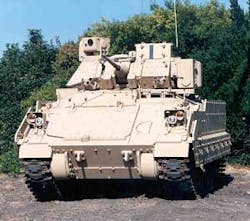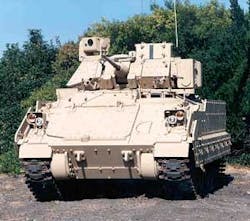Army uses Curtiss-Wright controllers for Bradley Fighting Vehicle
U.S. Army systems designers needed electrical components such as circuit-card assemblies for the Bradley Fighting Vehicle.
They found a solution with Curtiss-Wright Controls Inc. in Gastonia, N.C. According to this contract, designers at Curtiss-Wright will make components including power distribution, weapons controllers, and sight-selection controllers for the Bradley A2, A2ODS, and A3 variants.
The company won a $9 million contract for the job, awarded by the Army’s Tank, Automotive and Armaments Command (TACOM) in Rock Island, Ill.Under the agreement, Curtiss-Wright will deliver more than 2,000 circuit-card assemblies and line-replaceable assemblies by the end of 2005. Electrical components will be manufactured at Curtiss-Wright’s Littleton, Mass., facility.
“We’ve been involved with the Bradley for years and we’re proud the Army has chosen us to continue supporting this important program,” says George J. Yohrling, president of Curtiss-Wright Controls Inc. “Curtiss-Wright Controls takes our responsibility very seriously, especially during the critical periods ahead when the Army will be repairing, overhauling, and ‘resetting’ its fighting machines after extended operations in Iraq.”
Headquartered in Gastonia, N.C., Curtiss-Wright Controls is the motion-control segment of Curtiss-Wright Corp. The group makes niche motion-control products, subsystems, and services for the aerospace and defense markets. For more information, see www.cwcontrols.com.
ComputersSGI computers drive Saab flight simulator
Engineers at Saab Aerosystems in Linkoping, Sweden, needed a visualization computer for their Gripen flight simulators. They chose a solution from Silicon Graphics Inc. (SGI) Visualization Systems, Mountain View, Calif.
Saab’s new flight simulator, called PETRA (Planning, Evaluation, Training, Rehearsal and Analysis), is for planning, evaluating and debriefing - for either simulated or real-life missions - as well as for basic training and rehearsal exercises, mission rehearsal in training, and analysis of tactical scenarios.
Saab will use four SGI Onyx visualization systems to simulate the Gripen C/D, the latest version of the fighter aircraft. SGI Onyx delivers the computer power to process the vast amounts of visualization data from satellite photos, terrain elevation data, and terrain features to provide the most accurate and visually realistic environment for pilot training.
“We chose the SGI system for its 3-D graphics processing power and speed and because it offers visual representation of complex data in superior image quality, with full anti-aliasing,” says Stefan Sandberg, manager of training systems, Saab Aerosystems. “With Onyx system, we can synchronize up to eight visual channels and run the simulator at a consistent 60 Hertz. Only the Onyx can supply the fluid production of images without any gaps or anything disturbing the training session for the pilots. Only SGI can support the realism we require: accurate down to 1-meter resolution.”
The Saab Aerosystems purchase includes four 16-processor SGI Onyx 350 visualization systems with SGI InfiniteReality4 graphics subsystems and 16GB of shared memory. Onyx 350 will drive the up to 8-channel display system, which is configured as a half dome with a 2-meter radius and a plus/minus 120-degree field of view. Saab runs its own proprietary on top of SGI OpenGL Performer open-platform application programming interface. For more information, see www.sgi.com.
SoftwareI-Logix software runs Meteor missile
Missile systems engineers at MBDA, Westlake, Calif., needed design software to develop METEOR, a beyond-visual-range, air-to-air missile (BVRAAM).
They found a solution with Statemate from I-Logix, Andover, Mass. Statemate is a graphical design, simulation, and prototyping tool for the rapid development of complex embedded systems across distributed teams.
MBDA is the prime contractor for the METEOR Program, part of a multinational defense agreement signed in December 2002 by the United Kingdom, France, Germany, Italy, Sweden, and Spain. BAE Systems, EADS, and Finmeccanica own MBDA jointly.
The METEOR missile will be incorporated in to the next generation of European fighter aircraft including the Eurofighter Typhoon, Dassault Rafale, and Saab Gripen.
METEOR’s key features include stealthy launch, enhanced propulsion system motor performance, and robust countermeasures, all made possible by the algorithm system which controls missile guidance, navigation, airframe, propulsion, and RF signal processing.
Statemate will create, navigate, update, check, simulate, and analyze the algorithm system. Statemate models can be shared electronically with other members of the design, development, and testing teams to facilitate collaboration worldwide, a significant feature as the algorithm development teams are located at multiple sites throughout the U.K., France, and Sweden. For more information, see www.ilogix.com.
SoftwareSmiths picks Seaweed for C-130 upgrade
Engineers at Smiths Aerospace, Grand Rapids, Mich., needed software for the C-130 Avionics Modernization Program (AMP). Smiths is doing the work for prime contractor Boeing.
They found a solution at Seaweed Systems, Woodinville, Wash. Seaweed will deliver its DO-178B Level A-certifiable embedded graphics driver product (Seawind/178-3D). This product is based upon a certifiable subset of the OpenGL API.
Smiths will use an open-systems approach to modernize much of the C-130’s existing avionics suite. Their graphics applications will run on top of Seaweed’s SeaWind/178-3D, tailored for Smiths’ two different hardware platforms. Smiths will use one graphics platform based upon 3Dlabs’ P9 Visual Processor Unit (VPU) and one based upon 3Dlabs’ P10 VPU. In both cases the VPU parts will be provided and supported by Seaweed directly under their embedded market Distribution Agreement with 3Dlabs.
The common software architecture specified for the C-130AMP program is aimed at improving interoperability and supportability across multiple subsystems and hardware variants, and will use Wind River Systems’ VxWorks AE-653 Real Time Operating System (RTOS). The graphics subsystems will make use of Seaweed’s SeaWind/178-3D graphics driver ported to run under VxWorks AE653. For more information, see www.seaweed.com.
SoftwarePendulum test tool uses Nucleus RTOS
Engineers at Pendulum Instruments, in Bromma, Sweden, needed a software tool to help develop their test and measurement tool, the CNT-90.
They found a solution in the Nucleus real-time operating system (RTOS) from Accelerated Technology, Mobile, Ala.
The CNT-90 is a tool for measurement, analysis, and calibration of frequency, time interval, or phase. Whether in test systems, on the research and development bench, in the calibration lab, or out in the field, the CNT-90 offers ease of use with its graphical display and improved control, the company says.
Developers at Pendulum chose Nucleus because of its rich feature set, optimized performance, and royalty-free licensing model. They also use add-on components like the Nucleus prototyping tools, real-time kernels, and GRAFIX portable graphics software package.
“There is a constant push from the market to combine short development times, low development and production costs with the best possible performance,” says Staffan Johansson, vice president of sales and marketing at Pendulum Instruments. “To meet these high requirements, we needed an RTOS that combined good real-time behavior with a cost-effective, non-royalty-based pricing model, while at the same time bringing us up to speed with what we do best: developing the high performance and high-speed measurements our customers expect.” For more information see www.acceleratedtechnology.com.
ComponentsGeneral Dynamics helps build MUOS sat-com network
Engineers at Lockheed Martin Space Systems, Sunnyvale, Calif., needed components for the Mobile User Objective System (MUOS), the narrowband satellite communications system they are building for the U.S. Navy.
They found a solution with General Dynamics C4 Systems, Scottsdale, Ariz. Under an $830 million contract, General Dynamics designers will provide the user-entry and integrated ground segments.
MUOS will provide simultaneous voice, video, and data communication for warfighters on the move.
General Dynamics will lead the development and deployment of the MUOS ground system that provides communications and control interfaces between the MUOS satellites and existing and future U.S. Department of Defense terrestrial communication networks. General Dynamics also will develop the wireless protocol for communication between those networks and the MUOS satellites.
The Pentagon will provide user terminals under the Joint Tactical Radio System (JTRS) program with an emphasis on handheld, soldier-worn units. For users, the MUOS system will provide familiar cell phone-like services with the satellites acting as very tall “towers” to allow warfighters on the ground to communicate directly with each other and their commanders virtually anywhere in the world.
MUOS will replace the military’s current narrowband tactical communications system, known as the Ultra High Frequency Follow-on (UFO) system. The anticipated launch date for the first MUOS satellite is 2010.
In September 2004, Lockheed Martin won a $2.1 billion prime contract to build the first two satellites and associated ground control elements by the Navy’s Space and Naval Warfare Systems Command (SPAWAR). The contract for up to five satellites has a total potential value of $3.26 billion. For more information, see www.generaldynamics.com.
Integrated CircuitsHarris chip drives Raytheon IFF system
Engineers at Raytheon needed a processor chip for their Identification Friend or Foe (IFF) system. They found a solution with Harris Corp.’s RF Communications Division, Rochester, N.Y.
Harris technicians will supply their Sierra II application-specific integrated circuit (ASIC) software and hardware architecture, designed to provide all of the security features necessary to interoperate with legacy Mode 4 IFF system transponders and interrogators, as well as future Mode 5 IFF implementations.
“This program win underscores the programmable-design benefits of the Sierra encryption products,” says Dick Rzepkowski, Harris RF Communications Division vice president, Government Systems and Programs. “Sierra’s programming simplicity helps to ensure a fast development schedule - well within program timetables to field these new IFF applications.”
Sierra II is a miniaturized programmable module that can be integrated into radios and other voice and data communication devices to encrypt classified information prior to transmission and storage. It is similar to its predecessor Sierra I and now encompasses a much broader range of functionality because of higher data-processing speeds, lower power consumption, increased algorithm support, and advanced programmability.
Raytheon is building the IFF system for the Air Defense Interrogator (ADI) program. For more information see www.harris.com.
Power ElectronicsNavy picks VPT power converters
Navy researchers needed DC-DC converters for next-generation shipboard radar systems. They chose a solution from VPT Inc., Blacksburg, Va.
VPT won a research and development contract to create a new class of DC-DC converters that satisfies the extreme thermal, reliability, size, weight, and cost requirements for the new radar systems.
Heat management is a crucial design feature, because the new systems will require up to 1 kilowatt of power. Low cost is also important, since each system will use thousands of converter modules.
“VPT intends to leverage its DC-DC converter technology, expertise, and military marketing strengths with the funding from the Navy to develop DC-DC converter modules that can be used by various prime contractors on several new phased-array radar programs,” says Dan Sable, president and chief executive officer of VPT.
For more information, contact VPT online at www.vpt-inc.com.




